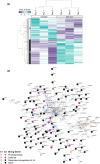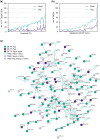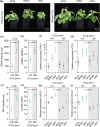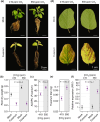Elevated CO2 alters soybean physiology and defense responses, and has disparate effects on susceptibility to diverse microbial pathogens
- PMID: 39788902
- PMCID: PMC12095978
- DOI: 10.1111/nph.20364
Elevated CO2 alters soybean physiology and defense responses, and has disparate effects on susceptibility to diverse microbial pathogens
Abstract
Increasing atmospheric CO2 levels have a variety of effects that can influence plant responses to microbial pathogens. However, these responses are varied, and it is challenging to predict how elevated CO2 (eCO2) will affect a particular plant-pathogen interaction. We investigated how eCO2 may influence disease development and responses to diverse pathogens in the major oilseed crop, soybean. Soybean plants grown in ambient CO2 (aCO2, 419 parts per million (ppm)) or in eCO2 (550 ppm) were challenged with bacterial, viral, fungal, and oomycete pathogens. Disease severity, pathogen growth, gene expression, and molecular plant defense responses were quantified. In eCO2, plants were less susceptible to Pseudomonas syringae pv. glycinea (Psg) but more susceptible to bean pod mottle virus, soybean mosaic virus, and Fusarium virguliforme. Susceptibility to Pythium sylvaticum was unchanged, although a greater loss in biomass occurred in eCO2. Reduced susceptibility to Psg was associated with enhanced defense responses. Increased susceptibility to the viruses was associated with reduced expression of antiviral defenses. This work provides a foundation for understanding how future eCO2 levels may impact molecular responses to pathogen challenges in soybean and demonstrates that microbes infecting both shoots and roots are of potential concern in future climatic conditions.
Keywords: Fusarium virguliforme; Glycine max; Pseudomonas syringae; Pythium sylvaticum; bean pod mottle virus; carbon dioxide; plant immunity; soybean mosaic virus.
© 2025 The Author(s). New Phytologist © 2025 New Phytologist Foundation.
Conflict of interest statement
None declared.
Figures









Similar articles
-
[GmWRKY33A positively regulates disease resistance in soybean (Glycine max)].Sheng Wu Gong Cheng Xue Bao. 2024 Oct 25;40(10):3810-3822. doi: 10.13345/j.cjb.230805. Sheng Wu Gong Cheng Xue Bao. 2024. PMID: 39467766 Chinese.
-
Arabidopsis nonhost resistance gene PSS1 confers immunity against an oomycete and a fungal pathogen but not a bacterial pathogen that cause diseases in soybean.BMC Plant Biol. 2012 Jun 13;12:87. doi: 10.1186/1471-2229-12-87. BMC Plant Biol. 2012. PMID: 22694952 Free PMC article.
-
Phenotypic Plasticity Conditions the Response of Soybean Seed Yield to Elevated Atmospheric CO2 Concentration.Plant Physiol. 2015 Nov;169(3):2021-9. doi: 10.1104/pp.15.00980. Epub 2015 Sep 15. Plant Physiol. 2015. PMID: 26373658 Free PMC article.
-
Genomic blueprints of soybean (Glycine max) pathogen resistance: revealing the key genes for sustainable agriculture.Funct Plant Biol. 2024 Apr;51:FP23295. doi: 10.1071/FP23295. Funct Plant Biol. 2024. PMID: 38669462 Review.
-
Salicylic acid and jasmonic acid in elevated CO2-induced plant defense response to pathogens.J Plant Physiol. 2023 Jul;286:154019. doi: 10.1016/j.jplph.2023.154019. Epub 2023 May 20. J Plant Physiol. 2023. PMID: 37244001 Review.
Cited by
-
Silicon Nanoparticles Alter Soybean Physiology and Improve Nitrogen Fixation Potential Under Atmospheric Carbon Dioxide (CO2).Plants (Basel). 2025 Jun 30;14(13):2009. doi: 10.3390/plants14132009. Plants (Basel). 2025. PMID: 40648016 Free PMC article.
-
Elevated CO₂: a double-edged sword for plant defence against pathogens.New Phytol. 2025 Jun;246(6):2380-2383. doi: 10.1111/nph.70048. Epub 2025 Mar 13. New Phytol. 2025. PMID: 40079636 Free PMC article.
References
-
- Aguilar E, Allende L, Del Toro FJ, Chung B‐N, Canto T, Tenllado F. 2015. Effects of elevated CO2 and temperature on pathogenicity determinants and virulence of potato virus X/potyvirus‐associated synergism. Molecular Plant–Microbe Interactions 28: 1364–1373. - PubMed
-
- Ahammed GJ, Li X. 2022. Elevated carbon dioxide‐induced regulation of ethylene in plants. Environmental and Experimental Botany 202: 105025.
-
- Ainsworth EA, Long SP. 2021. 30 years of free‐air carbon dioxide enrichment (FACE): what have we learned about future crop productivity and its potential for adaptation? Global Change Biology 27: 27–49. - PubMed
MeSH terms
Substances
Grants and funding
LinkOut - more resources
Full Text Sources

